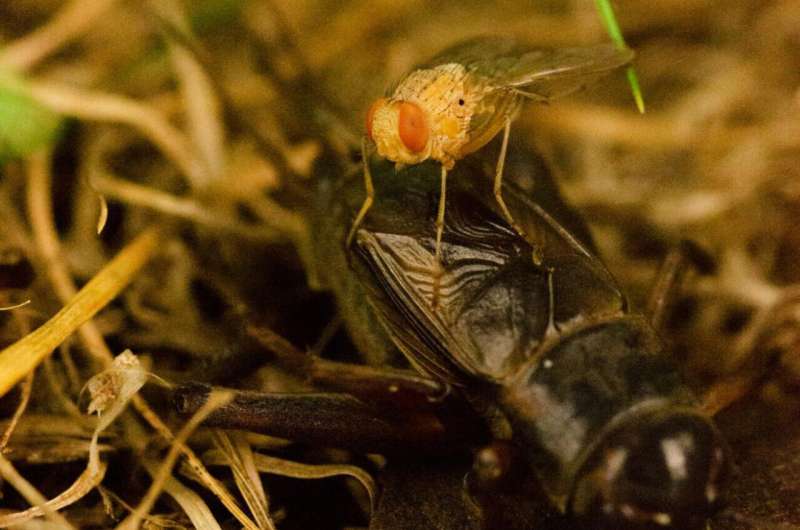This article has been reviewed according to Science X's editorial process and policies. Editors have highlighted the following attributes while ensuring the content's credibility:
fact-checked
peer-reviewed publication
proofread
New study reveals temperature-coupled song preferences in an eavesdropping parasitoid fly

Ambient temperature can affect acoustic communication signals produced by ectothermic signalers. For example, the temporal features of acoustic signals can occur at a higher rate at higher temperatures. If species recognition is based on evaluating these temporal features, temperature-related changes in signal features can compromise the ability of a receiver to recognize the signaler.
Temperature coupling—signal preferences shifting in parallel with signal features that change with ambient temperature—could be a solution for maintaining effective communication between signalers and intended receivers. A long-standing view is that this temperature coupling occurs within the same species, which may allow for genetic coupling and the potential for shared genetic basis underlying signal production in signalers and signal perception in intended receivers.
Now, researchers reporting August 16 in Proceedings of the Royal Society B have discovered that temperature coupling can also occur in unintended eavesdropping receivers of disparately related species, suggesting that temperature coupling can occur in the absence of genetic coupling.
Male field crickets sing by rubbing their wings together to produce calling songs that are used to attract female mates. These calling songs also attract the attention of gravid female Ormia ochracea in search of host crickets for the development of their larval young. As crickets are ectotherms and take the temperature of the surrounding environment, changes in ambient temperature can alter the temporal patterning of sound pulses in cricket chirps.
By 1897, scientists were already aware of this relationship, which allowed the famous American physicist and inventor Amos Dolbear to derive an equation (Dolbear's Law), using the cricket as a thermometer to measure the ambient temperature based on the timing of sound pulses in cricket chirps.
If cricket songs change with ambient temperature, can the acoustic parasitoid fly Ormia ochracea maintain their ability to recognize suitable host crickets? A study co-led by Kari Jirik and Jimena Dominguez, both members of the Lee Lab of Neural Systems and Behavior at St. Olaf College, have found that Ormia ochracea exhibit song temporal pattern preferences that change with ambient temperature in a way that parallels how ambient temperature affects the temporal features of cricket songs. This study is the first to describe in detail temperature-coupling between song features of a signaler and the song preferences of an unintended eavesdropping receiver.
"Since the pulse rate of cricket calling songs change when ambient temperature changes, we found that the pulse rate preferences of Ormia ochracea also shifted with ambient temperature," says Dominguez.
Along with other members of the Lee Lab, the research team described cricket song pulse rate preferences in Ormia ochracea by using a high-speed spherical treadmill system to record walking phonotactic responses to calling songs that varied in pulse rates under different ambient temperatures.
At a room temperature of 21 C, flies walked optimally to cricket songs with a pulse rate of 50 pulses per second, and walked less to cricket songs with higher or lower pulse rates. This peak of their pulse rate preference function shifted to a higher pulse rate (70 pulses per second) at 30 C. In addition to the shift in the peak of the pulse rate preference function, the team also found that flies became less selective and responded more readily to a wider range of pulse rates.
"Our results are cool because it introduces a new possibility of eavesdropping flies being able to recognize their host cricket songs across a wide range of temperatures, allowing gravid females to find host crickets even when the temperature fluctuates," says Dominguez.
As the rhythmic production of sound pulses in calling songs change with temperature, temperature-coupling of song preferences would be important for maintaining effective communication between male and female crickets of the same species. This is especially the case when the ambient temperature drops at dusk, during peak hours of acoustic communication among crickets.
"The temperature coupling of male signal features and female preferences for those features was thought to be possible because male and female crickets are genetically related and genetically coupled. Genetic coupling might allow for a common genetic basis underlying signal production and signal preferences," says senior author Norman Lee.
Temperature coupling in the absence of genetic coupling may occur if temperature affects cellular and metabolic processes in the same way in signalers and receivers. The precise mechanisms of how signal preferences and signal recognition change with temperature is currently unknown and warrants further investigation in future studies.
More information: Karina J. Jirik et al, Parasitoid–host eavesdropping reveals temperature coupling of preferences to communication signals without genetic coupling, Proceedings of the Royal Society B: Biological Sciences (2023). DOI: 10.1098/rspb.2023.0775
Journal information: Proceedings of the Royal Society B
Provided by St. Olaf College


















